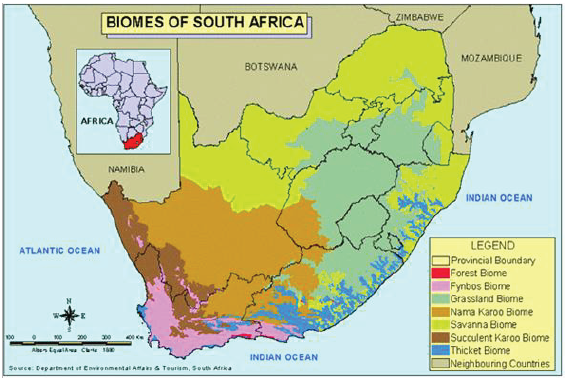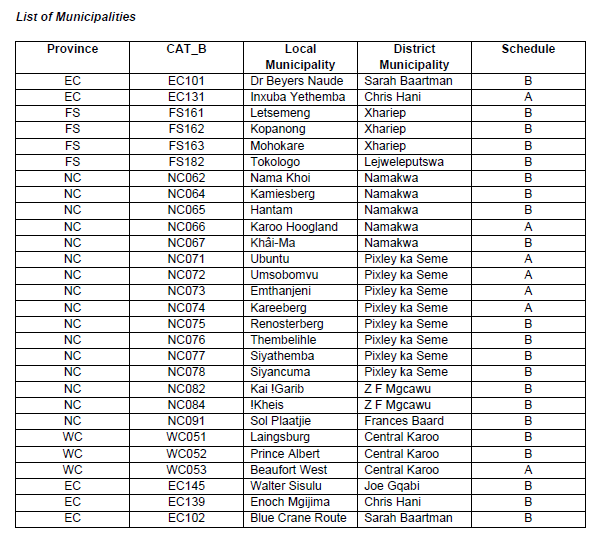


Agricultural Product Standards Act, 1990 (Act No. 119 of 1990)NoticesRegistration of Karoo Lamb/Karoo Lam as a South African Geographical Indication (GI)Annexure A : The Applicable Minimum Product Specifications for 'Karoo Lamb'/'Karoo Lam' |
| 1. | Type of Agricultural Product |
Karoo Lamb/ Karoo Lam is a (primary or processed) lamb meat product regulated in terms of sections 3(1) and 15 of the Agricultural Product Standards Act, 1990 (Act No. 119 of 1990) and that is intended for sale in the Republic of South Africa.
| 2. | Descriptions of the characteristics of KAROO LAMB/ KAROO LAM |
| 2.1 | Minimum Requirements for the claim |
The name KAROO LAMB/ KAROO LAM applies to all meat cuts from lamb produced under free range conditions and slaughtered in the geographical area as defined herein. Only lamb born, raised, and slaughtered in the geographical area as defined qualifies as the product concerned. The product must comply with the following specifications prescribed by the “Regulations regarding the Classification and Marking of Meat intended for sale in the Republic of South Africa” as published under no. R. 55 under Government Gazette no. 38431 on 30 January 2015.

Karoo Lamb meat has specific aromatic and sensory attributes, which can be directly attributed to the geographical area. Various scientific studies have shown that the grazing plants from the Karoo region as defined herein impart herbal and musty flavour attributes to meat from sheep breeds of this region.
The volatile composition of the fat of Karoo Lamb meat has a higher concentration of key terpenes, validating the direct link with the herbaceous plant samples and confirming the considerable differences between the Karoo region and other regions outside the geographical region as defined below.
| 2.2 | Designated geographical area |
The maps below show the geographical area in South Africa that is regarded as the “Karoo”, which is based on the geology of and natural vegetation appearing in that geographical area. The botanical biomes are classified as the “Nama Karoo Biome”, and “Succulent Karoo Biome”.
The Karoo shrubs listed in item 3.1 below are dominant in the Nama Karoo and provides the unique taste of Karoo Lamb meat. The Nama Karoo Biome is therefore the botanical definition of the Karoo region in light of the empirical evidence that the Karoo Lamb meat has a unique taste linked to the shrubs of the Nama Karoo.

| 2.3 | Nama Karoo Biome |
The Nama Karoo Biome occurs on the central plateau of the western half of South Africa at altitudes between 500 and 2000m, with most of the biome falling between 1000 and 1400m. It is the second largest biome in the region.
Based the geospatial information obtained from the Department of Environmental Affairs, the Nama Karoo biome covers 29.588 million hectares of South Africa’s land mass (or 25%). However, this number includes, villages, towns, roads, rivers, etc and if stripped out of the natural Karoo vegetation (shrubs and natural grazing) estimated as the grazing area classified as the Karoo is 19.33 million hectares.
The geology underlying the biome is varied, as the distribution of this biome is determined primarily by rainfalls in summer which varies between 100 and 520mm per year. This also determines the predominant soil type over 80% of the area which is covered by a lime-rich, weakly developed soil over rock. Although less than 5% of rain reaches the rivers, the high erodibility of soils poses major problems where overgrazing occurs.
The dominant vegetation is grassy, dwarf shrubland. The grasses tend to be more common in depressions and on sandy soils, and less abundant on clayey soils. The grazing rapidly increases the relative abundance of shrubs.
Prior research has identified the local municipalities situated within the Karoo geographical area as defined by the Nama Karoo Biomes. The map below shows how the Nama Karoo Biome intersect with the local municipalities.

Based on this information, the municipalities listed as “A” in the below list of municipalities form the core region. While in the municipalities listed as “B”, there is a possibility that certain farms could fall outside the typical vegetation area that define the Karoo. For this reason, individual farms applying as users in terms of Regulation 5 of the GI and Designation of Origin Regulations, from the municipalities listed as “B” need to be assessed to ensure that they comply with the definition of the Karoo. This is to ensure that the use of the registered KAROO LAMB/ KAROO LAM GI is as inclusive as possible and that it is not defined by political and administrative boundaries only.
The Nama Karoo biome is the core region of the Karoo geographical area which covers 19.33 million hectares of natural grazing located in the municipalities listed below.

| 3. | Descriptions of the production process |
| 3.1 | Natural Vegetation |
The typical Natural vegetation of the Nama Karoo and Succulent Karoo Biomes within the Great Karoo must be present on the farm from which the Karoo Lamb is sourced.
The farms falling outside the specified Nama Karoo and Succulent Karoo Biomes areas or on the border of these areas shall use the natural vegetation to determine whether they still qualify as being part of the Karoo. The natural vegetation which is typically associated with the Karoo include the following shrubs:
| (a) | Plinthus karrooicus (“Silverkaroo”) |
| (b) | Penzia spinescens (“Skaapbossie”) |
| (c) | Pentzia sphaerocephale (‘Berggansie”) |
| (d) | Pentzia lananta (“Blesbokkaroo”) |
| (e) | Pentzia globose (“Vaalkaroo”) |
| (f) | Pentzia calcarea (“Meerkatkaroo”) |
| (g) | Pentzia incana (“Ankerkaroo”) |
| (h) | Eriocephalus ericoides (“Kapokbossie”) |
| (i) | Eriocephalus spinescens (“Doringkapokbossie”) |
| (j) | Salsola glabrescens (“Rivierganna”) |
| (k) | Pieronia glauca/ Rosenia humilis (“Perdebos”) |
| 3.2 | Feeding |
The rules for the production for Karoo Lamb are therefore derived from the established fact that these and similar Karoo shrubs are unequivocally responsible for the physical, chemical, and organoleptic characteristics of the product. The production practices that would sustain this intrinsic attribute of the product is:
| (a) | Free range grazing on indigenous Karoo vegetation. |
| (b) | The occasional use of supplementary feeds e.g licks for animals grazing in the veld may contain cereals, silage, or any other natural plant matter with the natural grazing being the dominant feed intake. |
| (c) | No animal by-products are allowed in supplementary feeds. |
| (d) | In the case of long dry spells on specific farms or sub regions of the Karoo where grazing conditions have deteriorated to an extend that free range grazing is impossible then the production of Karoo Lamb will be rendered unavailable and the farms/ regions in the affected areas will not be able to produce Karoo Lamb during this period as there will be no natural vegetation. |
| (e) | Animals originating from feed lots (as opposed to free range grazing) in the Karoo do not qualify for use of the registered KAROO LAMB/ KAROO LAM GI. |
| (f) | Animals reared on cultivated or planted pastures, do not qualify for use of the registered KAROO LAMB/ KAROO LAM GI. |
| (g) | The use of routine antibiotics and the application of any hormones, growth promoters and/or stimulants are strictly prohibited. |
| 3.3 | Slaughtering |
Slaughtering shall take place at an abattoir in the Karoo geographical area that has been registered for meat classification in terms of the “Regulations regarding the classification and marking of meat intended for sale in the Republic of South Africa” (Government Notice No.R.55 of 30 January 2015).
Further processing i.e. cutting and packing may take place outside the Karoo area, provided traceability is maintained. The compliant abattoir to be used in the region by all Karoo farmers must not exceed the distance limit of 250km for the transportation of live animals.
| 4. | Traceability |
Animals raised on farms in the Karoo region through free range grazing on Karoo veld qualify as Karoo Lamb. Proof of origin of the animals must be provided through the traceability system of the qualifying abattoirs that need to verify that all animals delivered by the registered and listed owners, originate from farms in the defined Karoo region.